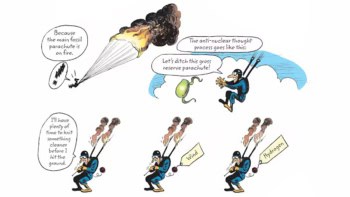
The number of very intense hurricanes striking the east coast of North America and the Caribbean could increase over the next century if ocean temperatures continue to rise. The total number of storms, however, is set to fall. That is according to researchers in the US who have applied a popular model for forecasting cyclone activity to a series of climate projections made by the Intergovernmental Panel for Climate Change (IPCC).
Hurricane Katrina, which struck the southern US including New Orleans in 2005, is an example of the sort of havoc that can be wreaked when North Atlantic cyclones make landfalls. Katrina was a category 5 hurricane, the most intense grade, where sustained wind speeds were as strong as 280 kilometres per hour. Since the 1980s there has been an increase in the number of category 4 and 5 hurricanes forming over the North Atlantic.
Meanwhile, several modelling groups have predicted that rising sea temperatures in the North Atlantic will lead – perhaps counter-intuitively – to a reduction in hurricane activity over the North Atlantic over the course of the 21st century. These climate models, however, fail to provide predict the nature of individual storms because they lack the spatial resolution to determine hurricane intensity. In this latest research Morris Bender and his colleagues at the National Oceanic and Atmospheric Administration (NOAA) have addressed this lack of data in a three-step process.
Seeking the eye of the storm
To begin with, Bender and colleagues predict the effect of rising sea temperatures on the large-scale flow of hurricanes over the Atlantic, with a resolution of about 200 km. They use data based on the average of 18 global models that contributed to the latest scientific report of the IPCC. In the second stage, the researchers feed this information into a regional model of atmosphere over the Atlantic, known as the ZETAC model. At this point, however, they have a spatial resolution of about 18 km, which can only produce storms of the lowest intensity – categories 1 and 2.
The key comes in the final stage when Bender’s team feeds the ZETAC data into a hurricane model that has been used by the US navy since 1995 to predict storms. In this way the researchers are able to resolve the intense winds that circulate close to the eye of the storm in type 4 and 5 hurricanes, made possible by a spatial resolution of 8 km. Called the GFDL Hurricane model, it predicts nearly a doubling of category 4 and 5 hurricanes by the end of the 21st century.
Bender admits that he did not expect quite such an increase, but he is not surprised that rising sea temperatures may have dramatic effects. “We may have the broad predictions for climate but the specific impacts and their locations are far from a done deal,” he tells physicsworld.com.
This research is published in Science.



